Snow, Hail, And Ice – The Differences Between Them And How Each One Is Formed
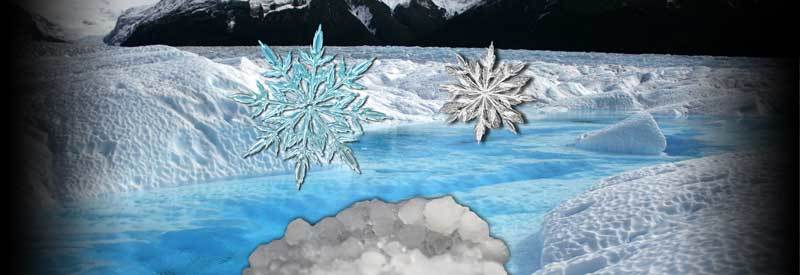
They may appear similar in many ways, but snow, ice, and hail are different not only in how they look and feel but also in how they are formed. We examine the main differences between them.
Water in its different solid states develops in the atmosphere as well as on the ground, and there is a multitude of factors involved in its formation. As a result, it can be difficult and confusing to distinguish between the different ice formations & their development.
The Difference Between Snow And Hail
Snow primarily forms in subzero temperatures when water vapor turns directly into ice crystals, which cling together to form snowflakes. Hail forms in thunderclouds where updrafts carry water droplets into subzero temperatures causing them to freeze into hailstones & bind to other waterdrops.
Readers living in Scandinavian countries, Canada, Russia, and other regions close to the Arctic Circle will probably find this subject very amusing. There are many readers, though, who experience the phenomena of ice, hail, and snow very seldom (if at all).
This article examines what ice, snow, and hail are and how they differ from each other by looking at how they are formed and defining their characteristics and structure.
It also takes a look at other forms of water in its solid state and how they relate to ice, snow, or hail. This includes well-known formations like sleet, ice rain, graupel, rime, and frost.
Ice - Definition And Formation
What Is Ice?

Ice can be seen as the umbrella term used to describe all forms of water in its solid state. When water in its liquid state is exposed to temperatures below freezing point (32° Fahrenheit or 0° Celsius) for a certain period, depending on time and temperature, it results in the hard, solid, and transparent substance we know as ice.
Apart from the hard and transparent (or semi-opaque if the ice contains impurities) nature of ice, it also differs from its liquid form in other ways.
Physical Nature Of Ice
Technically, ice still consists of 1 oxygen atom combined with 2 hydrogen atoms, which maintains water's transparent nature.
One important and sometimes overlooked difference between ice and water, is the fact that ice has a lower density than water. This is a result of the orientation of the hydrogen atoms as the temperature is lowered, pushing the water molecules further apart as it freezes and ice is formed.

This decreased density of ice also makes it lighter than water. This is why ice objects always floats on top of water. (Two examples are the icebergs floating in the ocean, and the ice covering and floating on top of a pond or lake.)
Another important feature of ice, is that it expands as water freezes and turns to ice. This means ice occupies a larger volume of space than water, which can be a potential problem.
Water in the cracks of building materials like concrete or stone, will expand when it freezes. This often leads to and expansion of the cracks in these materials which can weaken them and cause structural instability and potential collapse.
Flooding in buildings due to burst pipes are common in regions experiencing long periods of temperatures below freezing point. As the water in the pipes freeze, it expands causing many pipes to burst under the pressure.
As with all the other substances & phenomena in this article, the composition and features of ice are in some way a result of the way in which it was formed.
Formation Of Ice
As earlier stated, ice are formed when water is turned from its liquid form to its solid form by being exposed to temperatures below freezing point.
There are variety of ways in which ice can be formed, both on the ground and in the atmosphere. There is no need to explain each one in detail as most of these processes occur very much in the same way.
By use an example of ice forming on the ground and another of ice forming in the atmosphere, you will be able to get a much better understanding of ice formation in general.
On the ground, the formation of ice very often takes place in bodies of water (dams, ponds and the ocean) due to a drop in atmospheric temperatures. This is often seasonal as well, coinciding with the colder winter months in many countries.
During these cold winter months, many countries in the Northern Hemisphere closer to the Arctic Circle starts to experience temperatures well below freezing point. As the winter months arrive and temperatures starts to plummet, smaller bodies of water (like ponds) are the first to turn into ice.
Larger bodies of water take much longer, but over time the surface water of larger lakes starts to ice over, and parts of smaller rivers stops flowing as the water turns into ice.
A critical part of global ice formation, is the growth of the Polar Ice Caps in the Northern Hemisphere during winter months. As the temperatures continue to drop, the physical size of the North Pole increases by a significant margin as more ice is added on top and to the sides of this massive floating "continent" of ice.
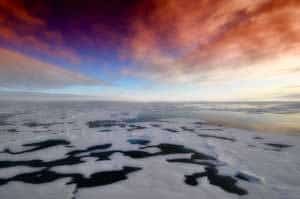
As the Northern IceCaps are not exposed to any direct sunlight during winter months, the temperatures drops very low. This allows the North Pole to physically expand and the sea ice to cover 15 million km² (5.8 million square miles) of the Northern Hemisphere during March when the IceCaps has grown to its maximum size.
The formation of ice on such a large scale annually, is vital for the regulation of the temperatures of the world's oceans, as well as helping to control the climate on a global scale.
In the atmosphere within cloud systems, ice is also formed when water is turned into its solid state as a result of subzero temperatures, but the process through which it takes place is quite different.
In big storm clouds, normally supercells or cumulonimbus clouds, a huge vertical buildup in the cloud system can occur where the clouds can reach heights well into the upper troposphere. This creates the perfect environment for the formation of ice.
These clouds normally contain a combination of powerful updrafts and downdrafts. As water vapor condensates into water droplets, it can be carried up higher into the clouds by updrafts.
With temperatures well below freezing point at these heights, the water droplets come in contact with supercooled water which cause ice to formed instantly on contact. It will start falling to the ground before being picked up by another updraft and come in contact with more supercooled water and other ice particles.
During this whole process, the ball of ice continues to grow in size until it becomes too heavy to stay in the air and falls to the ground, usually in the form of hail. (We will discuss hail in much more detail later on in the article.)
Sometimes though, temperatures are not below freezing point when water droplets are formed during condensation in a normal cloud. As they start falling, however, they sometimes travel through hundreds of meters of freezing air.
As a result, these waterdrops continue to be cooled to temperatures well below freezing point. These supercooled raindrops is called freezing rain (sometimes called ice rain), and as soon as these raindrops hit the ground or any other surface, it is instantly turned into ice.
From just these two or three examples just described, it should become very clear that there are a wide variety of ways in which ice can be formed, both on the ground and in atmosphere.
Variations Of Ice
But, at the end of the day, ice is just ice right? No matter how they are formed, the end result is still the same...
Well no, not exactly. When casually observed, all forms of ice may look the same, but if you took a closer look, you will notice some subtle but important differences.
What is even more important, is that different forms of ice has characteristics that makes them react differently to their environment. By just looking at a few examples, you will be able to understand why not all ice are "created equal."
Freshwater Ice: This is probably the most common form of ice, as freshwater is the most abundant type of water found in our rivers, dams, lakes, reservoirs and households. They have the common characteristics of "normal" ice and also freeze consistently at temperatures below 32° Fahrenheit or 0° Celsius.
Sea Ice: At the name suggests, sea ice is formed when ocean water is turned into ice due to a drop in temperature to below freezing point. But it is here where its characteristics differ from freshwater ice. Due to the amount of salt in seawater, sea ice takes much longer to form than freshwater ice. (Seawater gets more dense as it cools down and sinks away from the surface.) The freezing point is also much lower at -1.8° Celsius (28.8° Fahrenheit) prolonging the formation of sea ice even further.

Glaze Ice: When supercooled waterdrops (ice rain) hits any surface it instantly form a thin clear layer of ice with a very smooth surface. This is a particularly dangerous form of ice when formed on surfaces like roads and pavements. They are almost invisible to the naked eye and very smooth, making it very easy for motorists, pedestrians and cyclists to slip on.
Hail: We already discussed hail in some detail and will do so in much more detail later on in this article. But as we have already seen, hail is formed in the atmosphere in storm clouds when water droplets collide with supercooled waterdrops in the upper atmosphere in subzero temperatures, instantly turning them to ice in the process.
These are just four examples of many variations of ice and the many forms it take. Next time you see a piece of ice that didn't come out of refrigerator, remember "ice is never just ice".
Snow - Definition And Formation
What Is Snow?
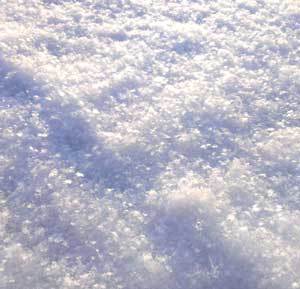
Essentially, snow is a collection of ice crystals that are formed around a pollen or dust particle as a result of the condensation of water vapor in sub-zero temperatures (below 32° Fahrenheit or 0° Celsius) in the atmosphere. When these ice crystals start clinging together snowflakes are formed. As more crystals are added to a snowflake, it grows in size and weight until it becomes too heavy and starts falling to the ground as a result of the earth's gravity.
The most obvious difference between snow and ice can be found in the way they are structured. A snowflake is much lighter and fragile than a similar volume of ice, which is much more dense and almost solid in structure.
Physical Nature Of Snow
The soft and light structure of a snowflake (or any piece of snow) is a direct result of the fact that it is made up out of a number of ice crystals with pockets of air trapped within them.
Each snowflake is hexagonal (six sided) in shape, simply because they are mainly made up out of hexagonal plates, prisms, star-shaped (hexagonal) ice crystals.
It is is important to note though, that even though they might have the same shape, no two snowflakes are the same. Each one has its unique properties.
Snow are also white in color as they reflect all the colors in the color spectrum, which creates a white color when combined.
If you look at a snowflake in detail, you will see that it is made up of many different elements when viewed under magnification. Naturally, the multitudes of ice crystals that are bound together play center-stage when looking at the snowflake up close.
Among some of the other elements found in a snowflake, includes microscopic pieces of pollen and dust (around which many of the ice crystals are formed), as well as pockets of air containing oxygen, nitrogen, and a few other elements commonly found in atmospheric air.
Formation Of Snow
We are very familiar with snow falling from the sky in the form of snowflakes. Just like ice though, snow can be formed both in the atmosphere and on the ground.
In the atmosphere, ice crystals are formed when the temperature is already well below freezing point. Instead of forming micro water droplets, water vapor condenses directly around small particles of dust or pollen to form ice crystals (a process called deposition), creating their unique hexagon shaped structure.
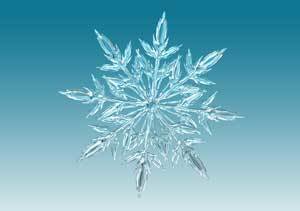
As the ice crystals start to come in contact and cling to each other, a snowflake is formed. Snowflakes retain its hexagonal shape as already explained, resulting in plenty of "air pockets" to be trapped inside the snowflake.
This allows a snowflake to be much lighter and less dense than a similar sized ball of ice. The combination of the ice crystals' structure and air pockets inside, also allow snow to be easily transformed and compacted.
On the ground, snow is also formed through an accumulation of ice crystals in the form of hoar frost. The formation of hoar frost is very similar to that of snowflakes in the atmosphere but takes place on the ground via contact with objects with subzero temperatures.
On the ground, a variety of objects (lampposts, fences, leaves, branches among others) may be exposed to subzero atmospheric temperatures, lowering their own temperatures to well below freezing point.
As humid air containing water vapor comes in contact with these cold objects, it is instantly frozen and turned into ice crystals. As these ice crystals accumulate, the same type of "snow" found in the atmosphere, is formed on tree branches, fences, and other cold objects. This is called hoar frost.
Variations Of Snow
Just like ice, snow also comes in a variety of different forms that are very often a result of the way in which they were formed. Just by looking at a few different examples this will become very obvious.
Atmospheric Snow: The most common form of snow with which most of us are also familiar with. Ice crystals are formed in subzero temperatures in the atmosphere, starts clinging together and form snowflakes. After reaching a certain size and weight, the snowflakes fall to the ground as a result of the earth's gravitational force.
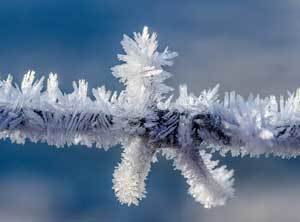
Hoar Frost: This process also involves water vapor that is turned directly into ice crystals. Unlike ice crystals in the atmosphere though, this process takes place on the ground where humid air comes in contact with objects with temperatures below freezing point, instantly allowing the water vapor in the air to be turned into ice crystals upon contact.
Sleet: Another form of snow is called sleet (often confused with ice rain). When snowflakes are formed and starts falling to the ground, it sometimes fall through a warmer layer in the atmosphere which melts the snowflakes and are turned into waterdrops in the process.
As it continues to fall, it may travel through another layer of subzero atmospheric temperatures, causing the waterdrops to freeze and fall on the ground in the form of small ice pellets called sleet. (Unlike ice rain, it is already turned into ice pellets before hitting the ground, not in contact with the ground as is the case with ice rain.)
Graupel: Sometimes referred to as "snow pellets", graupel is formed when snow falls through an area of supercooled water. Upon contact, the supercooled water freezes around the snowflake and rime it, and graupel is formed as a result.
This process alters the shape and appearance of the snowflake, often resembling the appearance of hail. This is why graupel is sometimes referred to as "soft hail". It is still technically snow, as it is not nearly as solid as hail and the small layer of ice around the snowflake does not change the density of the snowflake itself.
These four examples provide plenty of proof that snow are formed in a variety of ways and comes in all shapes and sizes.
Hail - Definition And Formation
Hail has already been mentioned a few times during the course of this article (and a few external articles on this website) and are essentially a subcategory of ice.
Yet, it differs in so many ways from other forms of ice, and is such a unique & important occurrence on its own, with its potentially devastating impact on the environment, it really deserves its own complete section.
As already mentioned, hail is essentially a form of ice. However, as you will soon discover, it differs so drastically in its structure and especially in the way it is formed, that in a way it can be seen as an entirely different entity.
What Is Hail?
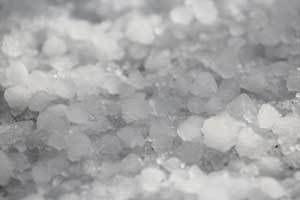
Essentially hail is solid layered balls of ice formed as water droplets are carried up high into the atmosphere through updrafts in huge storms systems (like supercells and cumulonimbus clouds). At these high altitudes, they are exposed to temperatures well below freezing point, causing them to freeze and turn into hailstones.
A they are carried through additional updrafts and downdrafts in the storm clouds, additional layers are added until the hailstones grow too big to be kept in the air, and falls to the ground as a result of gravity.
Physical Nature Of Hail
Simply by looking at the structure a hailstone, it should become clear how much it differs from the "normal" ice commonly formed on the ground.
Upon closer inspection, it becomes clear very quickly that hailstones have a roundish, but more importantly, a predominantly irregular shape. This differs dramatically from the structured hexagonal shape of snowflakes (made up out of ice crystals).
This is a direct result of the fact that snowflakes are formed from the hexagon-shaped ice crystals which allow snowflakes to maintain this six-sided structure. Unlike snow though, hail is formed from waterdrops (and not ice crystals), and therefore has no fixed structure.
As supercooled water and other small ice particles attach themselves to a hailstone from different sides as it is carried through updrafts and downdrafts, a very irregular shaped hailstone is formed.
A hailstone is formed through a series of supercooled waterdrops, small pieces of ice particles, and water droplets building up around it in a storm cloud. A result, the hailstone has a distinctly layered structure, very much like the peels of an onion. (This is very visible when looking at a cross-section of a hailstone.)
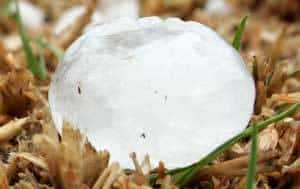
When you look at some of the other characteristics of hail, its translucent color is also very characteristic of this particular frozen form of ice. It is not fully transparent as it is made up of multiple layers of different ice, with some impurities also finding its way into the hailstone structure.
The irregular shape of hailstones also hinders its transparency and contributes to the translucent color commonly associated with hail.
Hailstones also come in a variety of sizes, from as small as 5 millimeters (0.2 inches) to 15 centimeters (6 inches) in diameter. The size of a hailstone is determined by a variety of factors including the size of the storm cloud, the strength of updrafts/downdrafts, the amount of moisture in the air, and the vertical extend (height) of the cloud system.
Bigger hailstones can cause severe damage to buildings, vegetation, as well as motor vehicles. It can also cause serious injuries and even be fatal if human beings are struck. This is especially the case once hailstones reach the size of tennisballs, baseballs or larger objects.
Formation Of Hail
We already briefly touched on the formation of hail, but let's take a more indepth look at how a hailstone is formed.
Before looking at the formation process, let me just quickly dispel a myth that exists surrounding hail. It does not need to be cold and stormy on the ground in order for a hailstorm to occur. The weather can be perfectly tolerable or even slightly warm right before a hail starts falling.
There are few conditions however, that needs to be in place to ensure the formation of hail:
- A sufficient amount of moisture (water vapor) in the air.
- Strong updrafts.
- Storm clouds with a large vertical extent (distance from the cloud base to the upper region of the cloud), sometimes reaching up to 16 km (10 miles) in height
- Hail embryos in the form of very small pieces of soft ice or frozen raindrops sometimes referred to as graupel.
- Supercooled water droplets in the upper regions of the cloud system.
- Lowered freezing level heights.
Not all of these conditions needs to be present for the formation of hail. Neither will the presence of each and every one of these conditions guarantee the formation of ice.
What it means is simply that the presence of these conditions provides the best possible environment for hail to form. Each one's role will soon become clear.
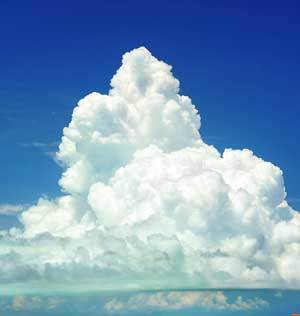
As already mentioned, a strong storm cloud (preferably in the form of a supercell or cumulonimbus cloud) forms the ideal environment for hail formation. These clouds contain strong updrafts as well as a large vertical buildup that is conducive to hail development.
As water vapor rises up into altitudes with lower temperatures, condensation takes place and water droplets are formed. These water droplets get caught by updrafts and carried up high into the atmosphere (sometime 16-17 kilometers), with temperatures well below freezing point, where the water droplets are turned into ice.
As the updraft weakens or the frozen raindrop gets caught in a downdraft, it is pulled back down to the ground. As it falls through the cloud, it comes in contact with supercooled water droplets and water vapor, which builds up around frozen raindrop, adding to its size and weight and a hailstone starts forming.
When the hailstone is caught by another strong updraft, it is carried back up into the cold upper atmosphere where the process repeats itself. This cycle will continue until the hailstone becomes too big and heavy for the cloud to hold it in the air and the hailstone falls to the ground.
The size of the hailstones reaching the ground largely depends on the size and extent of the storm cloud itself, the strength of the updrafts, and the amount of moisture in the air.
Variations Of Hail
Since hail is already a subcategory of ice, breaking it further down will be confusing. There are, however, two substances closely related to and often confused with hail. I already discussed them earlier in the article, but need to emphasize their difference from hail as it relates to their structure and formation:
Sleet: Often mistaken for smaller hailstones, sleet is actually something completely different. The small frozen ice pellets hitting the ground is actually snow that has melted into water as it fell through a warmer section of air, only to subsequently fall through a layer subzero temperatures which caused them to be frozen into ice pellets.
Graupel: As previously mentioned, graupel is formed when snow falls through an area of supercooled water. Upon contact, the supercooled water freezes around the snowflake and rime it, which forms graupel. It may resemble hail, but is nothing more than ice covered balls of snow which can be easily deformed and crushed.
Conclusion
If you managed to read through this whole article without your head spinning, congratulations! This topic can be very confusing and can lead to debate and disagreement.
For this very reason I broke this article up into the differences between ice, snow and hail. They cover the major types of water (or water vapor) in its frozen form.
Naturally, as you have seen, there are many more variations, mostly based on physical characteristics and formation. There is also a lot of overlap between the different categories, but all of them can essentially be placed in one these 3 main categories.
I trust this article helped you to better understand all the different forms of water in its frozen form, as well as clear up any confusion you may have about it.
Feel free to leave me any comments, questions or suggestions, and I will get back to you as soon as possible.
Never miss out again when another interesting and helpful article is released and stay updated, while also receiving helpful tips & information by simply clicking on this link .
Until next time, keep your eye on the weather!
